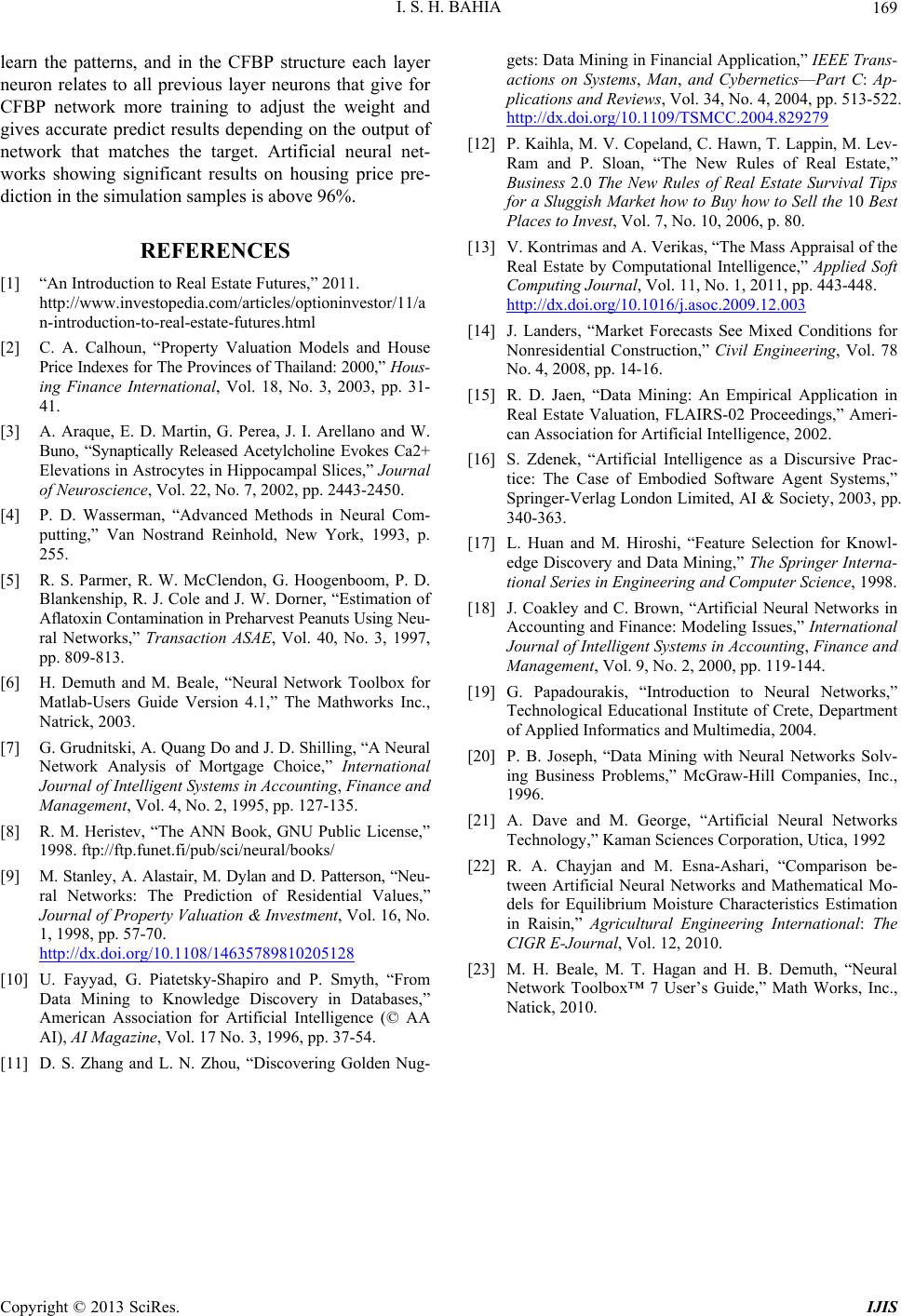
I. S. H. BAHIA 169
learn the patterns, and in the CFBP structure each layer
neuron relates to all previous layer neurons that give for
CFBP network more training to adjust the weight and
gives accurate predict results depending on the output of
network that matches the target. Artificial neural net-
works showing significant results on housing price pre-
diction in the simulation samples is above 96%.
REFERENCES
[1] “An Introduction to Real Estate Futures,” 2011.
http://www.investopedia.com/articles/optioninvestor/11/a
n-introduction-to-real-estate-futures.html
[2] C. A. Calhoun, “Property Valuation Models and House
Price Indexes for The Pr ovinces of Thailand: 2000, ” Hous-
ing Finance International, Vol. 18, No. 3, 2003, pp. 31-
41.
[3] A. Araque, E. D. Martin, G. Perea, J. I. Arellano and W.
Buno, “Synaptically Released Acetylcholine Evokes Ca2+
Elevations in Astrocytes in Hippocampal Slices,” Journal
of Neuroscience, Vol. 22, No. 7, 2002, pp. 2443-2450.
[4] P. D. Wasserman, “Advanced Methods in Neural Com-
putting,” Van Nostrand Reinhold, New York, 1993, p.
255.
[5] R. S. Parmer, R. W. McClendon, G. Hoogenboom, P. D.
Blankenship, R. J. Cole and J. W. Dorner, “Estimation of
Aflatoxin Contamination in Preh arvest Peanuts Using Neu-
ral Networks,” Transaction ASAE, Vol. 40, No. 3, 1997,
pp. 809-813.
[6] H. Demuth and M. Beale, “Neural Network Toolbox for
Matlab-Users Guide Version 4.1,” The Mathworks Inc.,
Natrick, 2003.
[7] G. Grudnitski, A. Quang Do and J. D. Shilling, “A Neural
Network Analysis of Mortgage Choice,” International
Journal of Intelligent Systems in Accounting, Finance and
Management, Vol. 4, No. 2, 1995, pp. 127-135.
[8] R. M. Heristev, “The ANN Book, GNU Public License,”
1998. ftp://ftp.funet.fi/pub/sci/neural/books/
[9] M. Stanley, A. Alastair, M. Dylan and D. Patterson, “Neu-
ral Networks: The Prediction of Residential Values,”
Journal of Property Valuation & Investment, Vol. 16, No.
1, 1998, pp. 57-70.
http://dx.doi.org/10.1108/14635789810205128
[10] U. Fayyad, G. Piatetsky-Shapiro and P. Smyth, “From
Data Mining to Knowledge Discovery in Databases,”
American Association for Artificial Intelligence (© AA
AI), AI Magazine, Vol. 17 No. 3, 1996, pp. 37-54.
[11] D. S. Zhang and L. N. Zhou, “Discovering Golden Nug-
gets: Data Mining in Financial Application,” IEEE Trans-
actions on Systems, Man, and Cybernetics—Part C: Ap-
plications and Reviews, Vol. 34, No. 4, 2004, pp. 513-522.
http://dx.doi.org/10.1109/TSMCC.2004.829279
[12] P. Kaihla, M. V. Copeland, C. Hawn, T. Lappin, M. Lev-
Ram and P. Sloan, “The New Rules of Real Estate,”
Business 2.0 The New Rules of Real Estate Survival Tips
for a Sluggish Market how to Buy how to Sell the 10 Best
Places to Invest, Vol. 7, No. 10, 2006, p. 80.
[13] V. Kontrimas and A. Verikas, “The Mass Appraisal of the
Real Estate by Computational Intelligence,” Applied Soft
Computing Journal, Vol. 11, No. 1, 2011, pp. 443-448.
http://dx.doi.org/10.1016/j.asoc.2009.12.003
[14] J. Landers, “Market Forecasts See Mixed Conditions for
Nonresidential Construction,” Civil Engineering, Vol. 78
No. 4, 2008, pp. 14-16.
[15] R. D. Jaen, “Data Mining: An Empirical Application in
Real Estate Valuation, FLAIRS-02 Proceedings,” Ameri-
can Association for Artificial Intelligence, 2002.
[16] S. Zdenek, “Artificial Intelligence as a Discursive Prac-
tice: The Case of Embodied Software Agent Systems,”
Springer-Verlag London Limited, AI & Society, 2003, pp.
340-363.
[17] L. Huan and M. Hiroshi, “Feature Selection for Knowl-
edge Discovery and Data Mining,” The Springer Interna-
tional Series in Engineering and Computer Science, 1998.
[18] J. Coakley and C. Brown, “Artificial Neural Networks in
Accounting and Finance: Modeling Issues,” International
Journal of Intelligent Systems in Accounting, Finance and
Management, Vol. 9, No. 2, 2000, pp. 119-144.
[19] G. Papadourakis, “Introduction to Neural Networks,”
Technological Educational Institute of Crete, Department
of Applied Informatics and Multimedia, 2004.
[20] P. B. Joseph, “Data Mining with Neural Networks Solv-
ing Business Problems,” McGraw-Hill Companies, Inc.,
1996.
[21] A. Dave and M. George, “Artificial Neural Networks
Technology,” Kaman Sciences Corporation, Utica, 1992
[22] R. A. Chayjan and M. Esna-Ashari, “Comparison be-
tween Artificial Neural Networks and Mathematical Mo-
dels for Equilibrium Moisture Characteristics Estimation
in Raisin,” Agricultural Engineering International: The
CIGR E-Journal, Vol. 12, 2010.
[23] M. H. Beale, M. T. Hagan and H. B. Demuth, “Neural
Network Toolbox™ 7 User’s Guide,” Math Works, Inc.,
Natick, 2010.
Copyright © 2013 SciRes. IJIS